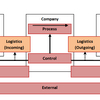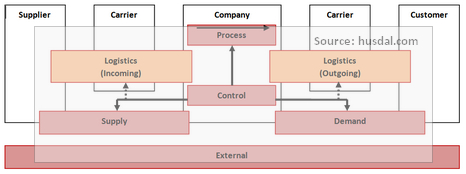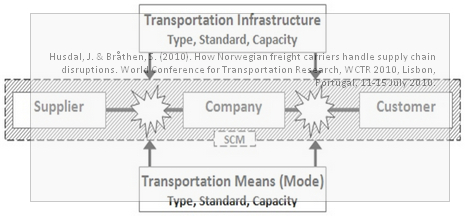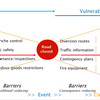 A couple of weeks ago I blogged about the flexibility of the logistics provider and how the transport provider plays an important role in supply chain operations, ensuring that they run smoothly and are able to move goods quickly from one place to another. However, relying on a third-party provider for logistics, or 3PL in short, is not without caveats. While there are significant benefits, there are also a number of challenges. That is what Al Ansari and Batoul Modarress investigated in a paper titled Challenges of outsourcing logistics to third-party providers. Here they identify four major challenges a company faces when choosing the right 3PL: current requirements, future growth, information exchange and security.
A couple of weeks ago I blogged about the flexibility of the logistics provider and how the transport provider plays an important role in supply chain operations, ensuring that they run smoothly and are able to move goods quickly from one place to another. However, relying on a third-party provider for logistics, or 3PL in short, is not without caveats. While there are significant benefits, there are also a number of challenges. That is what Al Ansari and Batoul Modarress investigated in a paper titled Challenges of outsourcing logistics to third-party providers. Here they identify four major challenges a company faces when choosing the right 3PL: current requirements, future growth, information exchange and security.
Shippers and carriers – the missing link
Transport providers and carriers play an important role in supply chain operations, but having said that, Supply Chain Management often neglects the mundane side of physical distribution and transportation, and forgets that these activities form the backbone of SCM, as Helen Peck wrote in 2006, and many other papers have also highlighted the role of logistics in supply chain management, with the shipper-carrier-customer triad developed by Bask (2001) being one of my favorite models that describes this issue.

One of the best descriptions linking the risks and uncertainties within supply chains with risks and uncertainties in logistics is what I found in a German book on risk management in logistics, from which the above figure is adapted.
Benefits
Shippers use 3PL providers to improve operational efficiency and effectiveness, to reduce freight costs and to the quality of service, and to enhance flexibility in terms of delivery speed and customer service. Based on a survey of 126 shippers, the authors list the following major benefits:
- Fixed assets
- Reduction inutilization of fixed assets
- Reduction in information technology infrastructure
- Improvement in financial performance
- Increase in asset turnover
- Inventory investment
- Reduction in inventory investment
- Reduction in “cash to cash” cycle
- Improvement in inventory visibility
- Increase in inventory turnover rate
- Logistics costs
- Reduction in logistics costs
- Enhanced access to carriers and fleets
- Leveraged cost savings across SCM
- Shipper service
- Increased shipper logistics services
- Reduced cycle time
- Increased fill rates
- Information technology
- Improved access to timely and accurate information
- Access to skilled personnel
- Elimination of inefficiency
- Increased customer flexibility
Unfortunately, these benefits and their implications are not described any further, which perhaps was not the purpose of the paper in the first place. After studying the paper, I also think it is wrong to call this the “major” benefits, since they all appear as choices in the survey questionnaire, where the shippers are asked to label them as “Not important”, “Important” and “Most important”, and I would assume that some shippers marked some items as “Not important”, hence disqualifying them form being the included in the list of “major” benefits. Maybe I’m just playing devil’s advocate here…
Challenges
Having frowned at the list of benefits, what I think the authors did get right is the list of challenges. Albeit on a much smaller scale, it reflects what I myself found in my research on How Norwegian freight carriers handle disruptions:

Logistics represents the interface between outgoing and incoming flows, and logistics provision approaches the supply chain from two sides. On side are the transportation infrastructure and the transportation mode, the prerequisite for logistics. On the other side are the transportation means used within each mode, the operational side of logistics.
Finding the right 3PL isn’t easy, and failures, so the authors say, can more often than not be related to these top four issues:
- the incapability to meet the shipper’s specific logistics requirements
- the incompatibility of information systems between shipper and 3PL
- the failure of 3PL to meet a shipper’s future growth needs
- the lack of control and security at the 3PL.
Again, as the case with the “major” benefits, the “top four” challenges are the four choices available in the survey, which sort of defeats the notion of really selecting the four most important out of many possible challenges.
Recommendations
To address these challenges, shippers need to develop the appropriate metrics that can measure and capture the 3PL’s capabilities as to operations, finance and information systems.
- Operations
- Inventory management
- Transportation services
- adaptability to accommodate changes the shipper needs
- efficiency in providing services
- effectiveness in providing services
- flexibility in handling contingency plans
- agility – how fast they can respond to changes
- Warehousing facilities
- infrastructure that can meet future expectations
- availability of state-of-the-art technology at receiving and shipping locations
- maintaining a high level of inventory accuracy
- accuracy of orders processed
- on-time shipping
- cost savings and other factors
- Finance
- Information systems
Interestingly, transportation and warehousing is extremely well covered and detailed, while the other recommendations are only cursory treated in the paper.
Conclusion
In my opinion and to my knowledge, the paper correctly describes some of the benefits and challenges in outsourcing logistics to third party providers. However, while the survey population seems sufficient, the survey itself could have been better designed with more questions or variables that would have clearly defined the top top top benefits and challenges
Reference
Ansari, Al, & Modarress, Batoul (2010). Challenges of outsourcing logistics to third-party providers International Journal of Logistics Systems and Management, 7 (2), 198-218 DOI: 10.1504/IJLSM.2010.034426
Author links
- researchgate.net: Al Ansari
- zu.ac.ae: Batoul Modarress
Related posts
- husdal.com: Logistics risks in Germany
- husdal.com: Logistics risks in the Netherlands












